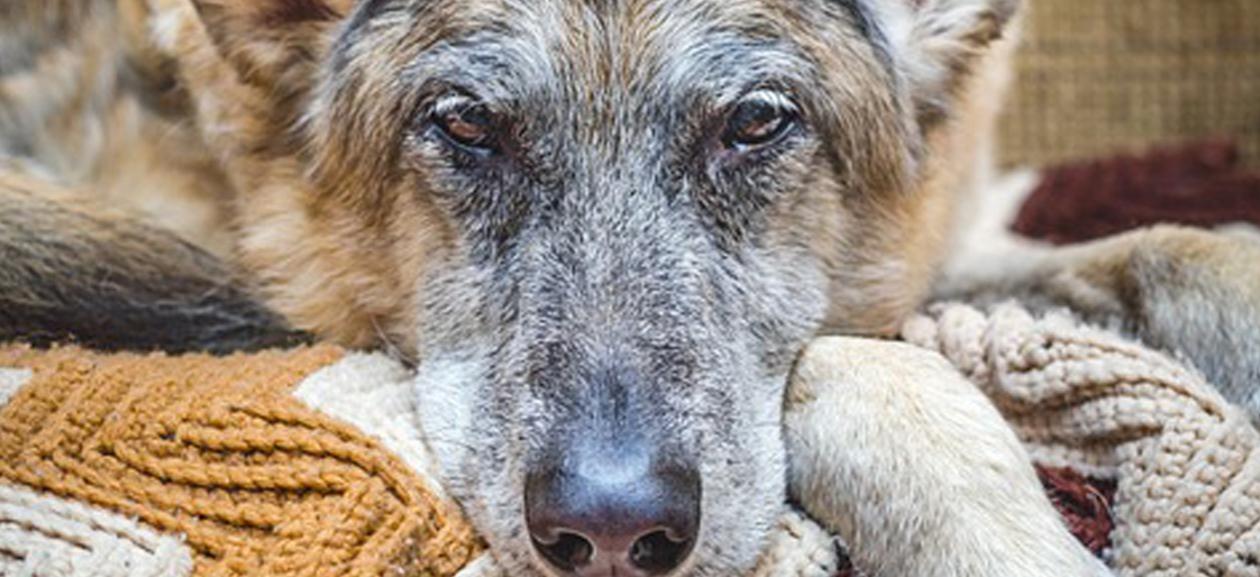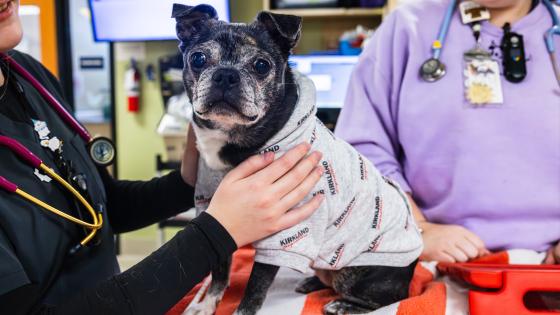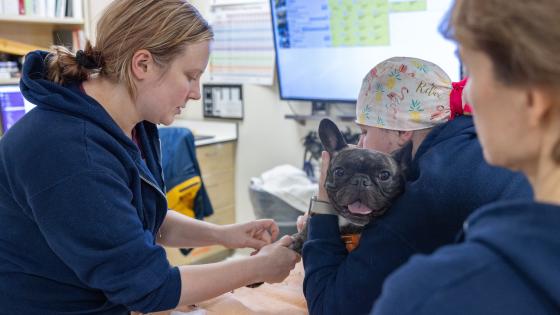
The New Normal: Living with an Elderly Dog
Just as no two dogs are alike, each dog’s aging process is also unique. But there are some universal ways to help our older furry friends make the most of life. Dr. Christy Michael shares advice for helping your dog stay healthy and happy well into their later years.
When is a dog considered senior or elderly?
It varies with each dog. Larger breeds tend to be elderly earlier than smaller breeds. If a dog develops illnesses as they get older, they can appear elderly before their time. I consider a dog to be geriatric if it starts to have trouble getting around or has issues with dementia.
What changes need to be made in a senior dog’s diet?
Most senior dogs should be changed to a diet that’s appropriate for older dogs. These foods are nutritionally balanced for things like joint support. They are also lower in calories to help combat obesity as they become less active. Some dogs will have additional nutritional needs if they have health problems. Always check with your vet before changing your dog’s food.
How often should a senior dog get veterinary checkups?
Older dogs should definitely get checkups at least once a year. An older dog with mobility issues or cognitive dysfunction or other health problems might see a vet twice a year. Younger dogs might get blood work tested sporadically, but a geriatric pet needs their blood work done once a year. This will allow your vet to monitor your pet’s health trends and look for specific abnormalities that might alert you to a problem. Addressing a problem early can prolong the life of your buddy.
What changes might an owner notice in their senior dog?
You’re going to see white hairs around their faces, muzzles, and sometimes other areas of their body. You might notice that their eyes look kind of cloudy or brighter white. Most commonly that is due to maturations of the eye lens, but it’s something to have your doctor look at, just in case.
You might see things like diminished vision and diminished hearing. Each dog handles this differently, so it may not be obvious right away, especially if your pet is in the same environment all the time. It might become clearer if they are unable to acclimate to new things in their environment or they become clingy. Dogs who lose their hearing sometimes bark more.
Your dog might also develop cognitive issues, which sometimes look like behavioral changes. They might start urinating or defecating in the house, which they’ve never done before. They might wake up in the middle of the night and start barking. But just because a change like this occurs, you should never assume it’s cognitive dysfunction. You should always get them checked by the vet because they could easily be caused by something else. Also, there are medications that can help with cognitive issues.
You might also notice that your dog develops arthritis – they have issues getting around the house, going up steps, and jumping on the bed. Long walks might make them a little more tired than they used to or might even make them sore or limp. With dogs experiencing these symptoms, you should always have a vet evaluate them to make sure it’s safe to go on long walks or exercise more intensely.
What can pet owners do to make their pets more comfortable with these changes?
Always touch base with your vet. There are nutraceuticals (supplements) that can help decrease the advancement of joint disease. There are also a variety of medicines that can help ease ailments from aging.
Weight management is also a really important part of dealing with arthritis in dogs. Heavier pets put significantly more stress on the joints, so it’s important to keep them lean. There is a study that compares lean dogs to obese dogs, and they found the healthier, lean dogs lived an average of two to three years longer.
What illnesses do doctors find most often in elderly dogs?
We see an increase in cancer, joint disease, thyroid diseases, and Cushing’s disease. Diabetes also starts to become more common as dogs get older, particularly if they are obese.
How can you tell the difference between general signs of aging (lethargy, decreased mobility, etc.) and a potential disease?
There’s really no way to tell for sure without a veterinary exam. They will need to do blood work and tests. We can only do so much with our hands and our eyes. We need the backup of a laboratory to confirm some conditions. Arthritis needs to be confirmed through X-rays; thyroid issues need to be confirmed through blood work. If your dog is slowing down, never assume that they are slowing down because of old age. Always have them checked out – especially if it’s a sudden change. The changes that we see due to aging don’t happen suddenly. They happen quite gradually.
Should dog owners encourage exercise and play as their dog ages?
Yes, exercise is good for everyone – both us and our pets. Just monitor their movement and make sure it’s appropriate for their level of health. If your pet has breathing issues or muscular skeletal issues, have your vet help you plan an exercise routine.
What can pet owners do to keep their dogs healthy as long as possible?
Keep them lean. Make sure they eat healthily and get exercise. Also, exercise their minds. Play games with them, play with toys and teach them tricks. Also, create a friendly space for them. Rugs give pets, especially senior pets, the traction they need to walk around and jump up to you.”There’s that old saying that you can’t teach an old dog new tricks, and it’s totally untrue. You can teach a dog tricks at any age. Teaching your dog tricks actually gives you bonding time with them, and it keeps their brains stimulated.
Should you restrict their interaction with other dogs?
An elderly dog doesn’t really need to change their interaction with other dogs, unless they have arthritis. Your arthritic dog should really be on a leash at all times when you’re outdoors. Make sure their activity is controlled – no unrestrained physical activity. It’s probably best to avoid dog parks, unless they prefer being around other dogs. And even then I would keep them on a leash.
If you bring a new dog or a young dog into the house, there can certainly be difficult interactions or issues between those animals, but that can happen no matter the age of the pets. Just make sure that you are protecting your older pet, especially if the younger pet is a little too exuberant. Make sure their time together is heavily supervised, especially in the first few months. If there are any specific issues – like during feeding time or when you let them outside in the backyard – make sure to protect your older dog from injuries.
How do you know that your elderly pet still has a good quality of life?
I very firmly believe that every person knows their pets better than anybody else. There is absolutely no way for me to tell another pet owner definitively when the time is right. You know what makes your dog happy. If my dog loves to run around outside, but he’s sustained a permanent injury that restricts him from doing that, I might think that he’s lost his quality of life. But if the only thing in the world that makes my dog happy is eating, and he’s still able to eat, I might carry on despite my dog’s age or health issues. You know what makes your dog happy. If it comes to a point where they can’t do the things they’ve loved to do their whole life, then that might be the time to say goodbye. Their people always know them best.




